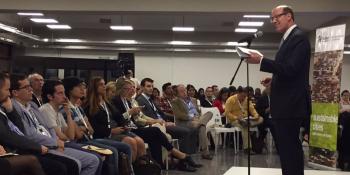
Reflections on Quito and The New Urban Agenda
by Patrick Kelley, Senior Director, the Terwilliger Center for Innovation in Finance, Habitat for Humanity International
Sitting here in Quito at Habitat III it is hard not to be amazed—amazed at the work that is being done and the staggering size of need that still needs to be addressed. Habitat III is about commitments and action. We know the issues. Many Sub-Saharan Africa countries have large and growing housing deficits that number in the millions. Cities and informal settlements around the world are growing at an accelerating rate. 1.6 billion people in need of shelter. Trillions needed in investment. The numbers are staggering.
But what I’m excited about are the solutions. The Terwilliger Center for Innovation in Shelter was officially launched by Jonathan Reckford, CEO, Habitat for Humanity International, at the Urban Stage, as one of the key Habitat for Humanity commitments to reach 8 million people by 2020, as part of the new Urban Agenda. Habitat for Humanity recognizes that philanthropic efforts alone will never be able to match the needs of so many people. In fact, most people around the world already rely on solutions for shelter that are available in the market, no matter how frail they are.
The Terwilliger Center for Innovation in Shelter’s primary aim is to build and expand inclusive affordable housing markets by mobilizing the flow of capital to the housing market; serving as facilitators and advisers to market actors; helping them identify the gaps in the housing market and to then develop the products and services best suited for them. The Terwilliger Center also advances the knowledge around housing markets through research, developing toolkits and publications, and public dissemination. The Terwilliger Center team also works to mobilize capital to grow and expand access to shelter solutions. The $100 million MicroBuild fund invests in the expansion of incremental house construction loans and the recently launched Shelter Venture Fund seeks to invest in entrepreneurial start-ups bringing the next generation of affordable products and services to the housing market. This approach is critical for Habitat’s commitment to catalyze private sector driven solutions to contribute to the New Urban Agenda and towards the achievement of the Sustainable Development Goals (SDGs) and targets, including SDG 11 of making cities and human settlements inclusive, safe, resilient, and sustainable.
A recent achievement that we are proud of comes from the “Building Assets, Unlocking Access,” project done in partnership with The MasterCard Foundation. In fact, during Habitat III, the project was presented at the networking session: bridging the gap for affordable housing for low-income groups, as an example of how by engaging key market actors, in this case working with local financial institutions , Habitat has helped over 18,000 families, and has mobilized nearly USD$16 million in Kenya and Uganda improve their homes and lives through housing microfinance. Globally, our Terwilliger Center is working in more than 50 countries and have mobilized almost $800 million in capital and served more than 2.5 million people. It may seem like a lot but with another 1.4 billion or so who still need help we have a ways to go. The Terwilliger Center is ready to help. And I’m glad I’m here in Quito to see how we can.